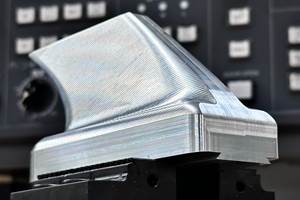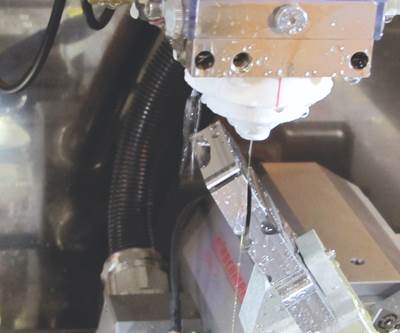Buying a Wire EDM, Part 1: How It Works
Wire EDMs can cut parts that require a level of accuracy, intricacy and fine surface finish that traditional machining methods cannot achieve. Here’s how it works.
Share





This is part one of a four-part series about buying a wire EDM. For more on Wire EDM, click the links:
- Part Two: Wire Considerations
- Part Three: Speed, Accuracy and Finish
- Part Four: Dielectric Fluid & Maintenance
Find more insights about acquiring a new machine tool by visiting the .
Wire electrical discharge machining (EDM) is widely used to create dies, punches, mold components, special tooling, extrusion dies, airfoils, gears, medical instruments, carbide cutters, toolholders, jewelry and thousands of workpieces too numerous to list.
Wire EDM’s Capabilities
Wire EDM can be used to cut electrically conductive materials to make parts that require a level of accuracy, intricacy and fine surface finish that traditional machining methods cannot achieve. A wire EDM unit can be programmed to cut complex shapes (small or large) to a dimensional tolerance of ±0.0001 inch and can be trusted to do so repeatedly and reliably. Unlike other types of machining, wire EDM exerts no cutting force on the workpiece and introduces no residual stress. There is little or no change in the mechanical properties of the material. Today’s wire EDM technology is capable of leaving virtually no thermal effects on the surface.
Wire EDM is best at cutting extremely hard materials such as tool steels, carbide, polycrystalline diamond (PCD), special alloys and parts requiring complex shapes, angles, tapers and sharp internal corners. Wire EDM can provide a surface finish as fine as 4 microinches Ra that may require no additional finishing or polishing. The wire EDM process leaves no burrs on the workpiece, a result that greatly reduces the need for subsequent operations. Wire EDM can be considered a time-saving, one-step process.
Wire EDM rarely calls for expensive workholding fixtures. One operator can run multiple machines.
How Wire EDM Works
A typical system consists of a CNC unit, a power supply with anti-electrolysis circuitry, a mechanism for automatic wire threading, a tank to contain the dielectric fluid, a chiller to keep the fluid at a steady temperature and a filtration system to keep the dielectric clean.
Wire EDM uses an electrically charged strand of wire fed from a reel and moved through upper and lower guides. The wire is energized as it passes across a power contact at the top and bottom. The distance between the guides can be adjusted to accommodate the thickness of the workpiece. A tightly controlled sequence of electrical discharges between the wire and the workpiece creates hundreds of thousands of sparks per second to remove the workpiece material. The heat of each electrical spark, estimated at around 15,000-21,000°F, melts away a microscopic bit of the workpiece material. Although the volume of metal removed during this short period of intense heat lasting 1 millionth of a second or less it is quite small, the frequency and multitude of sparks is an effective method to cut a narrow slot through very hard materials. The action of the spark may also remove material from the wire at the same time.
Submerging the wire and part in deionized water allows cutting debris to be flushed away. Splash flushing can be used when the part cannot be fully submerged, but a top and bottom nozzle must be constantly directed at the wire to help wash away debris. When machining submerged, cutting occurs in a more easily controlled environment and the flushing nozzles need to be adjusted only once.
A CNC unit moves the machine in an X-Y plane and can position the upper guide independently in the U-V axis, giving the machine the ability to move all four axes (X, Y, U, V) simultaneously to cut tapers or shapes that transition from top to bottom. A programmable Z-axis enables workpieces with different thickness to be machined automatically.
Related Content
Custom Workholding Principles to Live By
Workholding solutions can take on infinite forms and all would be correct to some degree. Follow these tips to help optimize custom workholding solutions.
Read More6 Variations That Kill Productivity
The act of qualifying CNC programs is largely related to eliminating variations, which can be a daunting task when you consider how many things can change from one time a job is run to the next.
Read MoreHow to Meet Aerospace’s Material Challenges and More at IMTS
Succeeding in aerospace manufacturing requires high-performing processes paired with high-performance machine tools. IMTS can help you find both.
Read MoreHow to Mitigate Risk in Your Manufacturing Process or Design
Use a Failure Mode and Effect Analysis (FMEA) form as a proactive way to evaluate a manufacturing process or design.
Read MoreRead Next
Buying a Wire EDM, Part 2: Wire Considerations
Each type of EDM wire has its strengths and weaknesses. This post reviews wire types, the importance of tensile strength and wire rethreading.
Read MoreMachine Shop MBA
Making Chips and 91ÊÓƵÍøÕ¾ÎÛ are teaming up for a new podcast series called Machine Shop MBA—designed to help manufacturers measure their success against the industry’s best. Through the lens of the Top Shops benchmarking program, the series explores the KPIs that set high-performing shops apart, from machine utilization and first-pass yield to employee engagement and revenue per employee.
Read MoreAMRs Are Moving Into Manufacturing: Considerations for Implementation
AMRs can provide a flexible, easy-to-use automation platform so long as manufacturers choose a suitable task and prepare their facilities.
Read More






















